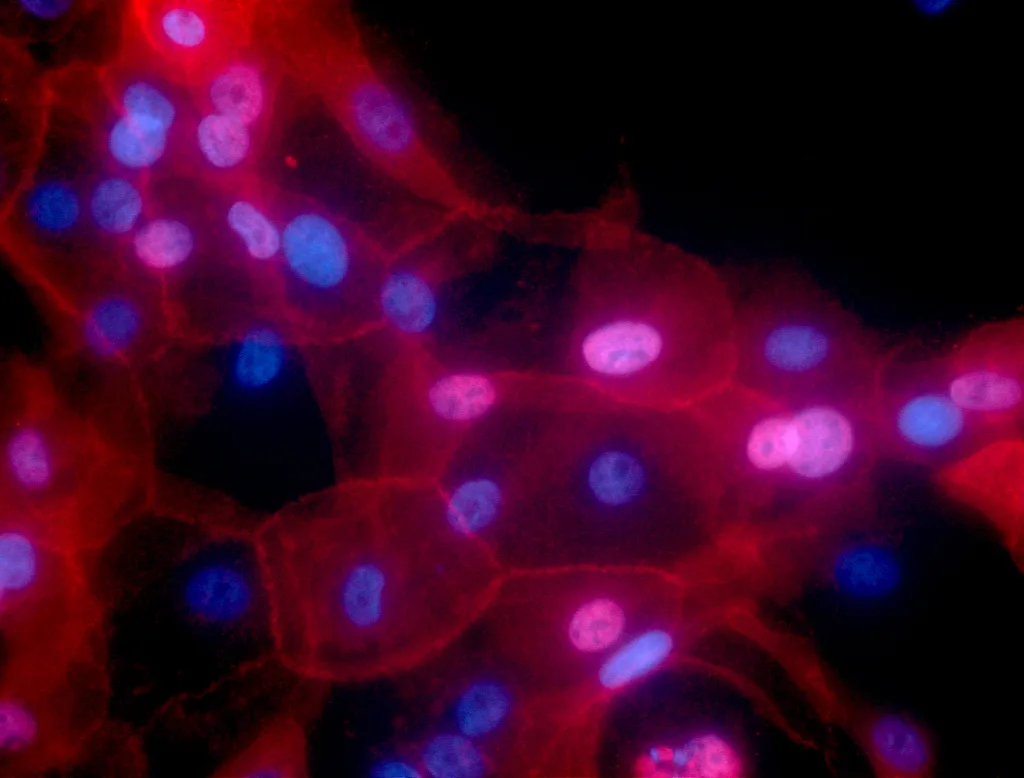Cancer treatments can put some cancer cells to sleep instead of killing them. Researchers are investigating if this is a reason the disease sometimes returns.
 Researchers are trying to unlock the secrets of senescent cancer cells which can cause the disease to come back. : Flickr: Ewa Krawczyk, National Cancer Institute / Georgetown Lombardi Comprehensive Cancer Center, National Institutes of Health CC BY-NC 2.0
Researchers are trying to unlock the secrets of senescent cancer cells which can cause the disease to come back. : Flickr: Ewa Krawczyk, National Cancer Institute / Georgetown Lombardi Comprehensive Cancer Center, National Institutes of Health CC BY-NC 2.0
Cancer treatments can put some cancer cells to sleep instead of killing them. Researchers are investigating if this is a reason the disease sometimes returns.
For cancer survivors, their greatest fear may be that one day the cancer will come back. Researchers are trying to understand how cancer can return to be better able to help them.
Many cancer treatments are designed to kill cancer cells. For the most part, they do a good job initially. But when cancer returns, the prevailing thought is that some cancer cells have eluded the treatment.
An overlooked outcome is that instead of being killed by the treatment, the remaining cancer cells have been forced to stop growing, entering a sleeping state known as senescence.
A cancer cell that isn’t growing may not sound very threatening, but senescent cancer cells have been changed dramatically.
Unlike normal cells or cancer cells that haven’t been exposed to treatment, senescent cells produce chemicals that can encourage the growth of blood vessels or cause inflammation, providing conditions that are ripe for refuelling cancer development and spread.
More concerning is that senescent cancer cells have the potential to resume growing as ‘zombie cancer cells’, often displaying heightened aggression and resistance to standard treatments.
This unpredictability has spurred excitement for identifying senolytic drugs, or drugs that will selectively kill senescent cells without harming normal cells.
The idea is that these drugs could provide a one-two knockout punch following initial cancer therapy.
Many senolytic drugs are already being trialled to treat age-related conditions such as Alzheimer’s disease, pulmonary fibrosis and diabetic kidney disease, which arise from an accumulation of senescent non-cancerous cells that have lost their normal function. Such cells naturally accumulate as we age.
But these drugs may also show promise in eliminating senescent cancer cells and preventing the re-emergence of cancer.
Despite the enthusiasm regarding this possibility, researchers are faced with two key challenges.
The first challenge is that there is currently no reliable way to distinguish a senescent cancer cell from other cells in the body that are not growing.
This is a concern in the treatment of cancer in aged people, as there can be unintended adverse side effects in non-cancerous organs and cells.
As a workaround, researchers are trying to develop strategies to measure metabolites specifically shed by senescent cancer cells into the blood.
Another strategy takes advantage of a protein commonly present on the surface of senescent cells. In early studies, scientists have been able to engineer immune cells that recognise this protein to eliminate senescent cancer cells and delay the return of cancer.
Alternatively, others are testing non-invasive imaging techniques in patients, such as positron-emission tomography–computed tomography, or PET-CT scanning, to assess the degree of senescence within tumours more accurately.
This technique would inform whether a senolytic drug might be a viable therapeutic option for treating cancer.
The second challenge is that not all senescent cancer cells are the same, and there is probably no ‘one-size-fits-all’ approach to eradicating them.
One senescent cancer cell may be killed by a senolytic drug, while another may be completely unaffected.
In the US, the Cellular Senescence Network is aiming to develop new tools and technologies to catalogue the differences between individual senescent cells.
Complicating matters, those in favour of the senolytic approach assume that senescent cancer cells are detrimental, but this might not always be the case.
Studies have shown that senescent cancer cells can stimulate stronger immune responses and enable immunotherapies to be more effective in recruiting immune cells to kill the senescent cancer cells to prevent cancer from coming back.
Researchers are alternatively seeking ways to boost the beneficial aspect of the senescence brake on cell growth while preventing the production of the pro-cancer chemicals, rendering them in a state of perpetual sleep.
In this case, killing a senescent cancer cell may not be needed.
A critical challenge facing researchers today is to understand what causes some senescent cancer cells to remain asleep and others to reawaken.
Of equal importance is understanding how senescence is presented in different cancer types, depending on different genetic backgrounds and treatment approaches.
Potential therapies that kill senescent cancer cells, harness the immune system to kill them, or prevent them from re-awakening will need to be tested in animal models of cancer that faithfully mimic human disease.
If these are then deemed effective and safe in clinical trials, they could be integrated into the arsenal of cancer treatments to ultimately achieve better outcomes for patients.
Dr Keefe Chan is a senior research officer at the University of Melbourne and Peter MacCallum Cancer Centre. He leads research on investigating cellular senescence, a type of cell growth arrest that occurs in response to many cancer therapies, with the goal of identifying approaches to harness it to treat breast and ovarian cancer.
Dr Chan’s research is funded by the Snow Medical Research Foundation, Eli Lilly and the United States Department of Defense.
Originally published under Creative Commons by 360info™.















